INTRODUCTION
MATERIALS AND METHODS
CT Scan Protocol
Table 1
CT Scan Protocols for Phantom Study

Image Reconstruction
Image Noise, Signal-to-Noise Ratio, and Contrast-to-Noise Ratio
 | Fig. 1Axial CT images of chest phantom obtained at reference dose level and 70 kVp.
A. Axial CT image reconstructed with FBP (B30f) demonstrates locations of three regions of interest (N, lung nodule; B1, air outside anterior chest wall; B2, right posterior lung). B. Axial CT image reconstructed with sinogram-affirmed IR with strength of 5 (I30f_5) shows decrease in image noise and increase in image blurring, compared with corresponding FBP image (A). In contrast, beam-hardening artifacts caused by simulated coronary arteries in phantom remain largely unchanged between two (A, B). C. Subtraction image between two CT images (B30f-I30f_5) clearly reveals subtle differences caused by application of IR algorithm that can be difficult to recognize by visual comparison. In addition to noise pattern, distinct outlines of chest phantom are seen on subtraction image, which can explain image blurring caused by IR technique. FBP = filtered back projection, IR = iterative reconstruction
|
Histogram-Based Analysis
 | Fig. 2Histograms of subtraction images between FBP and sinogram-affirmed IR images.Histograms of three subtraction images (B30f-I30f_1, B30f-I30f_3, and B30f-I30f_5) acquired at 70 kVp and reference radiation dose (A) and acquired at 70 kVp and 90%-reduced radiation dose (B) show gradually increased horizontal stretching with increased strength of IR algorithm. Of note, degree of their horizontal stretching is more pronounced at 90%-reduced radiation dose than at reference radiation dose for corresponding subtraction pairs. HU = Hounsfield units
|
Statistical Analysis
RESULTS
Image Noise, Signal-to-Noise Ratio, and Contrast-to-Noise Ratio
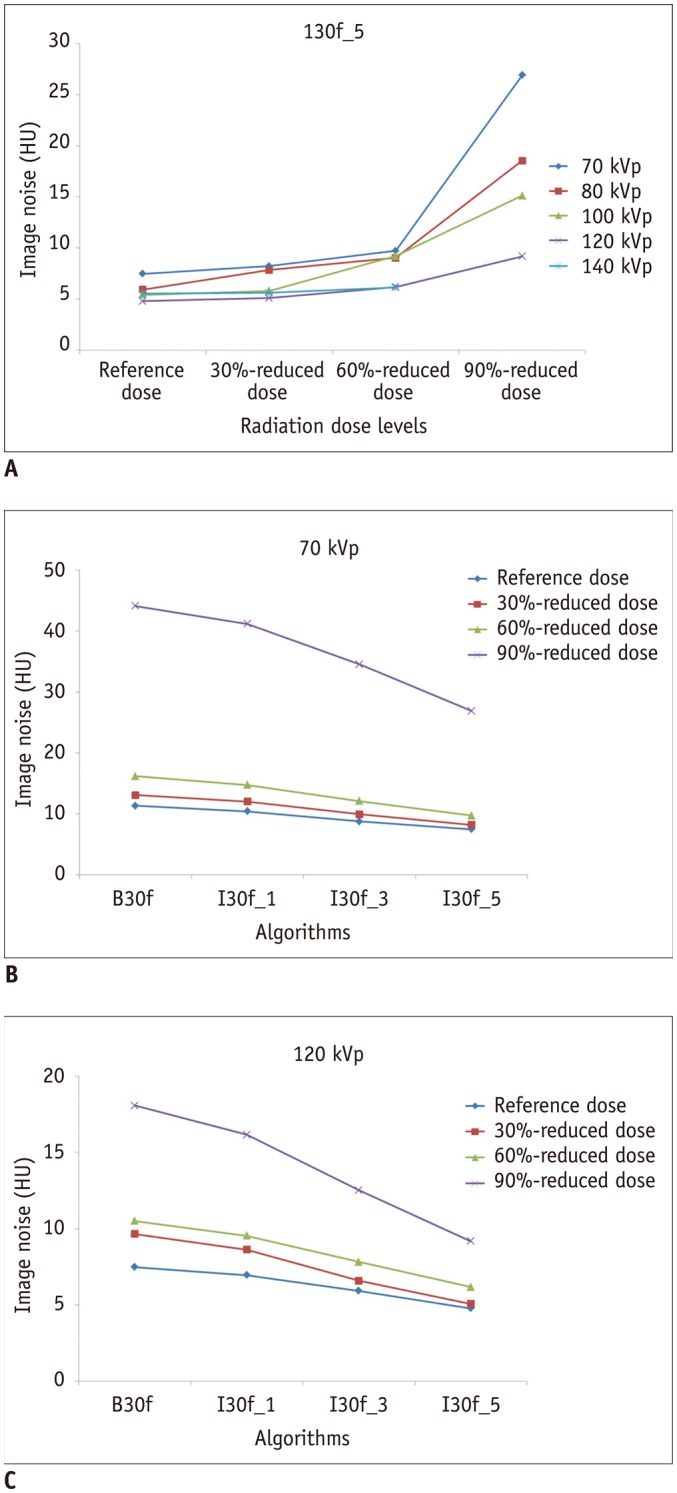 | Fig. 3Graphs demonstrating effects of radiation dose, tube voltage, and image reconstruction algorithm on image noise.
A. Graph shows markedly increased image noise of CT image reconstructed with sinogram-affirmed IR with strength of 5 (I30f_5) between 60%- and 90%-reduced radiation dose levels. B, C. Graphs demonstrate greater image noise reduction with higher strength of IR algorithm at 70 kVp (B) and 120 kVp (C). Greatest image noise change is also noted between 60%- and 90%-reduced radiation dose levels at both 70 kVp (B) and 120 kVp (C).
|
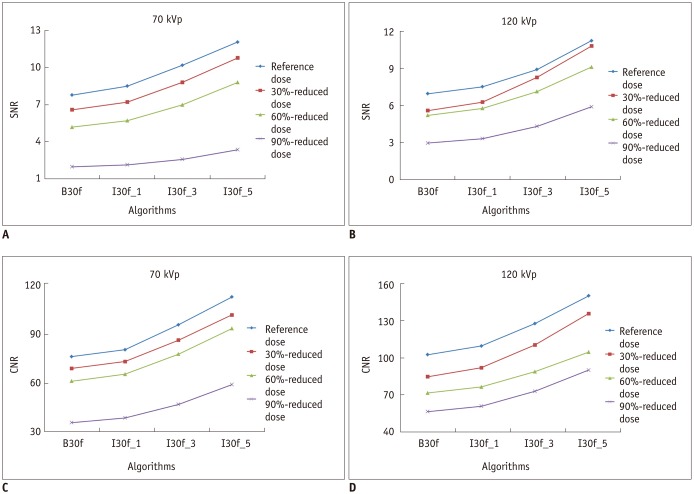 | Fig. 4Graphs demonstrating effects of radiation dose, tube voltage, and image reconstruction algorithm on SNR and CNR.
A, B. Graphs show greater SNR increase with higher strength of IR algorithm at 70 kVp (A) and 120 kVp (B). Greatest SNR change is noted between 60%- and 90%-reduced radiation dose levels at both 70 kVp (A) and 120 kVp (B). C, D. Graphs show greater CNR increase with higher strength of IR algorithm at 70 kVp (C) and 120 kVp (D). In contrast to SNR, greatest SNR change is noted between 60%- and 90%-reduced radiation dose levels at 70 kVp (C) but not at 120 kVp (D). CNR = contrast-to-noise ratio, SNR = signal-to-noise ratio
|
Table 2
Image Noise, SNR, CNR at Various Tube Voltages and Radiation Dose Levels
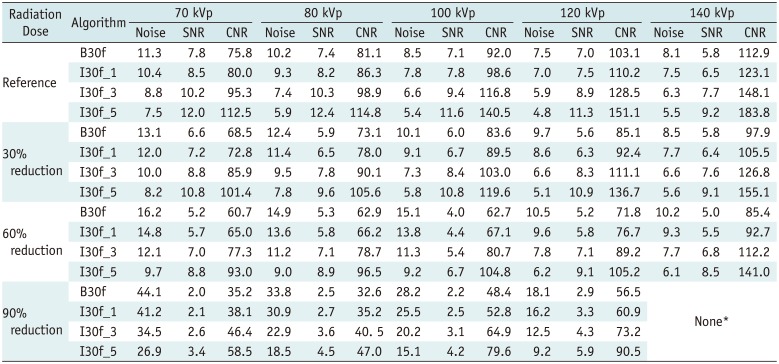
Histogram-Based Analysis
Table 3
Off-Centering of Histogram Peaks of Subtraction Images between CT Reconstruction Algorithms at Various Tube Voltages and Radiation Dose Reduction Levels
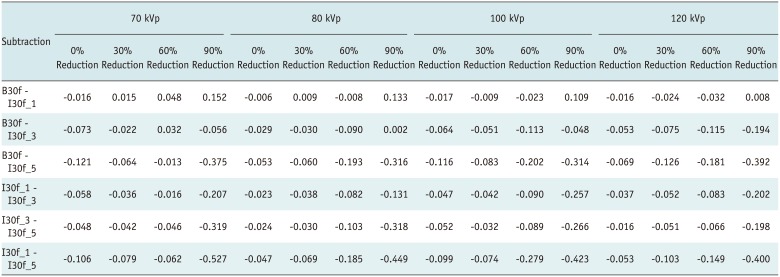
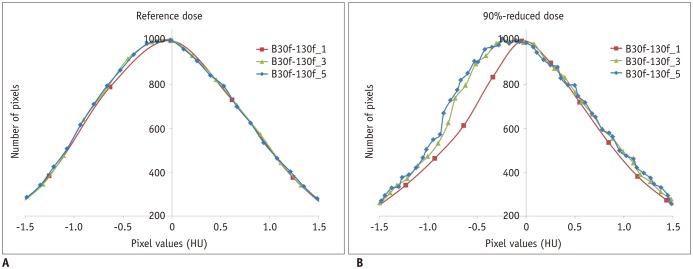 | Fig. 5Magnified standardized histograms of subtraction images between FBP and IR algorithm at 70 kVp.
A. At reference radiation dose, all three histograms are almost normally distributed and slightly skewed to right. B. At 90%-reduced radiation dose, histogram shows almost normal distribution for strength 1, but histograms show deviated and ragged appearance for strengths 3 and 5.
|
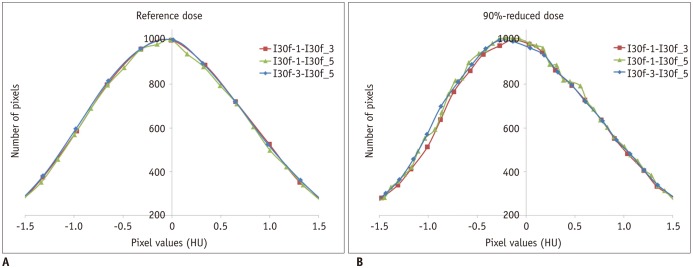 | Fig. 6Magnified standardized histograms of subtraction images between IR algorithms at 70 kVp.
A. At reference radiation dose, all three histograms are almost normally distributed. B. At 90%-reduced radiation dose, all three histograms appear minimally deviated and ragged as well as slightly skewed to right for all strengths.
|




 PDF
PDF ePub
ePub Citation
Citation Print
Print


 XML Download
XML Download